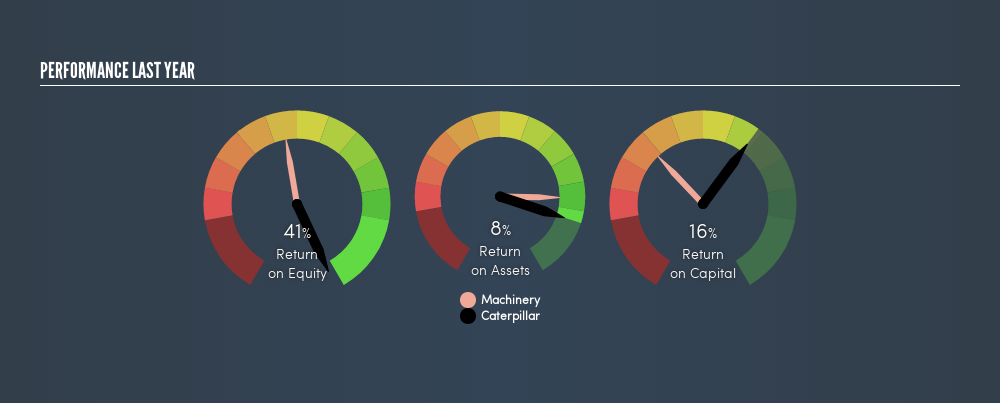- United States
- /
- Machinery
- /
- NYSE:CAT
Why Caterpillar Inc.’s (NYSE:CAT) Return On Capital Employed Is Impressive

Want to participate in a short research study? Help shape the future of investing tools and you could win a $250 gift card!
Today we are going to look at Caterpillar Inc. (NYSE:CAT) to see whether it might be an attractive investment prospect. Specifically, we're going to calculate its Return On Capital Employed (ROCE), in the hopes of getting some insight into the business.
First, we'll go over how we calculate ROCE. Second, we'll look at its ROCE compared to similar companies. Finally, we'll look at how its current liabilities affect its ROCE.
What is Return On Capital Employed (ROCE)?
ROCE is a metric for evaluating how much pre-tax income (in percentage terms) a company earns on the capital invested in its business. Generally speaking a higher ROCE is better. In brief, it is a useful tool, but it is not without drawbacks. Renowned investment researcher Michael Mauboussin has suggested that a high ROCE can indicate that 'one dollar invested in the company generates value of more than one dollar'.
So, How Do We Calculate ROCE?
The formula for calculating the return on capital employed is:
Return on Capital Employed = Earnings Before Interest and Tax (EBIT) ÷ (Total Assets - Current Liabilities)
Or for Caterpillar:
0.16 = US$8.4b ÷ (US$79b - US$27b) (Based on the trailing twelve months to March 2019.)
Therefore, Caterpillar has an ROCE of 16%.
See our latest analysis for Caterpillar
Does Caterpillar Have A Good ROCE?
ROCE can be useful when making comparisons, such as between similar companies. Using our data, we find that Caterpillar's ROCE is meaningfully better than the 11% average in the Machinery industry. We consider this a positive sign, because it suggests it uses capital more efficiently than similar companies. Separate from Caterpillar's performance relative to its industry, its ROCE in absolute terms looks satisfactory, and it may be worth researching in more depth.
As we can see, Caterpillar currently has an ROCE of 16% compared to its ROCE 3 years ago, which was 6.8%. This makes us think about whether the company has been reinvesting shrewdly.

When considering this metric, keep in mind that it is backwards looking, and not necessarily predictive. Companies in cyclical industries can be difficult to understand using ROCE, as returns typically look high during boom times, and low during busts. This is because ROCE only looks at one year, instead of considering returns across a whole cycle. Since the future is so important for investors, you should check out our free report on analyst forecasts for Caterpillar.
Caterpillar's Current Liabilities And Their Impact On Its ROCE
Liabilities, such as supplier bills and bank overdrafts, are referred to as current liabilities if they need to be paid within 12 months. The ROCE equation subtracts current liabilities from capital employed, so a company with a lot of current liabilities appears to have less capital employed, and a higher ROCE than otherwise. To counter this, investors can check if a company has high current liabilities relative to total assets.
Caterpillar has total liabilities of US$27b and total assets of US$79b. As a result, its current liabilities are equal to approximately 35% of its total assets. Caterpillar has a middling amount of current liabilities, increasing its ROCE somewhat.
Our Take On Caterpillar's ROCE
Caterpillar's ROCE does look good, but the level of current liabilities also contribute to that. Caterpillar looks strong on this analysis, but there are plenty of other companies that could be a good opportunity . Here is a free list of companies growing earnings rapidly.
For those who like to find winning investments this free list of growing companies with recent insider purchasing, could be just the ticket.
We aim to bring you long-term focused research analysis driven by fundamental data. Note that our analysis may not factor in the latest price-sensitive company announcements or qualitative material.
If you spot an error that warrants correction, please contact the editor at editorial-team@simplywallst.com. This article by Simply Wall St is general in nature. It does not constitute a recommendation to buy or sell any stock, and does not take account of your objectives, or your financial situation. Simply Wall St has no position in the stocks mentioned. Thank you for reading.
About NYSE:CAT
Caterpillar
Manufactures and sells construction and mining equipment, off-highway diesel and natural gas engines, industrial gas turbines, and diesel-electric locomotives in worldwide.
Undervalued with excellent balance sheet and pays a dividend.

